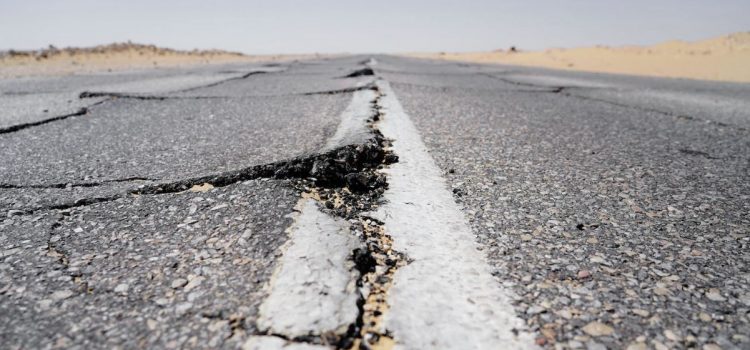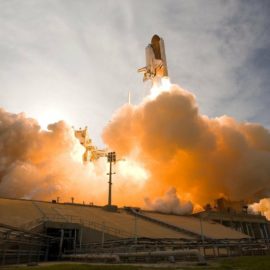

This article is an excerpt from the Shortform book guide to "Blowout" by Rachel Maddow. Shortform has the world's best summaries and analyses of books you should be reading.
Like this article? Sign up for a free trial here.
How does mining for oil and gas affect the environment? Does fracking natural gas really cause earthquakes?
According to her book Blowout, Rachel Maddow contends that there are many more negative effects of mining for energy sources than people think. Some of the impacts include poisoned soil, sick livestock and humans, increased global warming, and more.
Continue reading to learn how mining for energy impacts the environment.
How Energy Hurts the Environment
In her book, Maddow contends mining for energy impacts the environment negatively. She explains that oil and gas mining have both had devastating impacts on the environment over the last century, destroying ecosystems, poisoning the people who live near drilling sites, and contributing to climate change. Attempts to regulate the industry have stalled as energy magnates lobby for less government oversight and insist that scientific evidence showing the connection between their industry and environmental damage is either a hoax or ambiguous.
(Shortform note: Maddow doesn’t discuss the connection between cars and climate change, probably assuming that most readers are already familiar with this topic. As a brief overview, burning oil in the form of gasoline releases large quantities of carbon dioxide and other pollutants, which reduces air quality and contributes to global warming. The Intergovernmental Panel on Climate Change has advised that the world must significantly curtail its dependency on gasoline and other fossil fuels within the next 10-15 years or risk serious environmental effects.)
Fracking and Earthquakes
While the dangers of oil production have been known for decades, in the early 2000s gas was pitched as an eco-friendly alternative to fossil fuels. However, as Maddow points out, a series of accidents and slickwater leaks have revealed that the byproducts of fracking can be as harmful as an oil spill. In the 2010s, scientists proved that fracking could even cause devastating earthquakes.
Leaks
While slickwater itself is not especially dangerous, the process of fracking produces a number of toxic byproducts which emerge from drill sites alongside natural gas. This “flowback” water often contains radioactive material, and while some of it can be recycled for additional fracking, much of it needs to be disposed of. Maddow gives examples of how storage and transportation of flowback water in poorly designed tanks has resulted in leaks, poisoning soil, ponds, and farmlands near fracking sites.
Pets and livestock exposed to these waste products have become ill or died, and studies done on two affected families in Pennsylvania found that exposure gave them arsenic poisoning. While most leaks are accidental, in some states, such as North Dakota, gas companies illegally dumped fracking waste products onto Native American reservations or abandoned lots, careless of the effect they might have on nearby communities or water supplies.
(Shortform note: Aside from its waste products that can lead to arsenic poisoning, natural gas itself can be environmentally harmful; methane is a greenhouse gas and recent studies have suggested that the rise of fracking has contributed to global warming. Some gas is always leaked or deliberately burned off during the drilling process, and although methane is reabsorbed out of the atmosphere faster than carbon dioxide, it produces considerably more heat.)
Oklahoma’s Earthquake Crisis
Another way to dispose of flowback water is to inject it back into the earth once the drilling process is complete. Maddow notes that studies done throughout the 2010s found that these injections, which sent millions of gallons of waste product deep underground at high pressures, could cause earthquakes.
Between 1980 and the late 2000s, Oklahoma experienced around 40 earthquakes in total that scored above a 3.0 on the Richter scale. From 2010 on, however, Oklahoma experienced hundreds of powerful earthquakes every year, topping out at over 900 in 2015. Maddow argues that this sudden change can be attributed to a boom in the gas mining industry and the astronomical growth of the local Chesapeake Energy company.
| Earthquakes in the United States The Richter scale measures the magnitude and power of an earthquake, with each 1-point increase representing an increase in size by a factor of 10 (in other words, a 4.0 earthquake is 10 times larger than a 3.0 earthquake). Earthquakes measuring 3.0 are considered mild, with 2.0-3.0 being the range at which earthquakes can be felt by people in the vicinity. Earthquakes above a 5.0 can damage buildings and cause injuries, and California usually experiences two or three such quakes each year. Alaska, the most seismically active area in the United States, experiences hundreds of earthquakes each year and dozens above a 5.0. Though Oklahoma’s earthquakes never compared to Alaska’s in terms of severity, they approached this level of frequency by 2016, far surpassing the level of activity anywhere else in the continental United States. |
Though the connection between gas mining and earthquakes was suspected as early as 2010, according to Maddow, local energy magnates used threats and leveraged relationships with politicians to suppress research that suggested this link. However, in 2016 public outcry led the state government to enforce stricter regulations on gas companies. The Oklahoma Corporation Commission was empowered to shut down drill sites operating near fault lines or seismic activity, and energy companies must allow for real-time monitoring of their disposal operations. Maddow notes that as a result, the frequency of 3.0 earthquakes in Oklahoma has decreased dramatically, with less than 200 occurring in 2018.
(Shortform note: Although restrictions on fracking have reduced earthquakes in Oklahoma, some of the damage is long-term, and the state will continue to experience increased seismic activity for years to come. The fight against fracking and related earthquakes continues in other states and even worldwide, with the first deadly fracking-induced earthquake occurring in China in 2019.)

———End of Preview———
Like what you just read? Read the rest of the world's best book summary and analysis of Rachel Maddow's "Blowout" at Shortform.
Here's what you'll find in our full Blowout summary:
- A deep dive into the corruption and exploitation in the oil and gas industry
- Examples of how the discovery of oil can weaken a country
- Possible ways to protect the world from the energy industry






